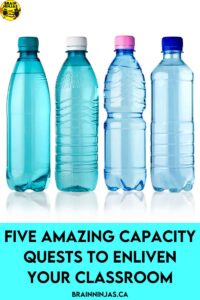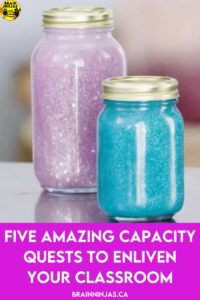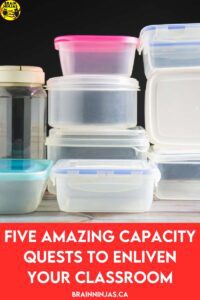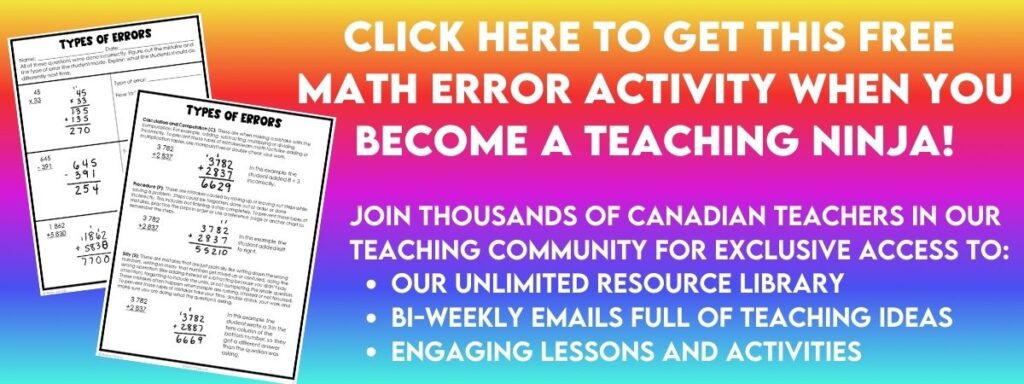
Teaching students how to calculate capacity using metric units is an essential skill in mathematics and in life. If you’ve ever tried to put your leftovers in the wrong container, you know it’s important to be able to use referents and measure containers properly. Finding resources that measure capacity in metric units can also be a challenge for teachers in Canada, but we have you covered. Learning about capacity is more than just using formulas. Come learn some of the ways we teach this measurement concept in our upper elementary classroom.
Introduce Capacity
The simplest way to explain the definition is the amount a container can hold. Some students will mix this up with volume. The volume of the container is the amount of space the container physically takes up or the amount of space the object inside the container takes up. If your students are confusing the two different measurements, stick to capacity for now.
Explain the different units. When we talk about capacity, we talk about the amount of liquid a container can hold. That means the most common units are millilitres (mL) or litres (L). If your students are learning about the metric system, discuss other units of measurement. You can also compare some of the common measurements used in cooking like cups or tablespoons and convert them to metric units.

Start With Hands-On Activities
Nothing helps more than doing some measuring. We recommend gathering all the measuring cups, measuring spoons, beakers, graduated cylinders, or anything else with a measurement in the units you are learning about.
In order for students to learn referents for the units, they will need to explore. A referent is a non-standard unit that can be used when estimating. For example, a millilitre is about the same as a water droplet.
Put students in small groups and give them a variety of containers and measuring tools. Have them explore the different containers.
If you have access to a pop can or bottle, have students measure the amount of water they can fit in the container. Does it match the label on the container? Based on the measurement, is the container measurement on the label talking about the capacity or the volume (it’s almost always the volume)?
Do a quick challenge to see if students can estimate using water. Ask students to put 250 mL of water in a container, but the catch is that they can’t use a measuring tool or a container with any units on it. Once they’ve “guessed,” pour the water out of the container into a measuring cup. How close was it? This challenge can be fun for students to see how close they can get to guessing the correct amount.
Use Paper Worksheets or Task Cards

Use worksheets or activities where students practice converting between millilitres and litres. This will help students as they work through other activities.
Use our worksheets. We’ve already written them for you. Our worksheets have plenty of space for students to work, and they include metric measurements. None of these require students to know or use any formulas. If you’re looking for some creative ways to use our worksheets, check out our post: Math Worksheet Games Your Students Will Love.
Capacity Worksheets (mL and L). These are for younger students in grades 3 or 4. The worksheets include word problems and a variety of questions that ask students to read measurements on containers. Find them in our TpT Store ($USD) or our BN Shop ($CAN).
Capacity Worksheets (mL and L). These are for older students in grades 5 or 6. The worksheets include word problems and a variety of questions that ask students to read measurements on containers or make estimates. Find them in our TpT Store ($USD) or our BN Shop ($CAN).
Capacity Task Cards (mL and L). Our task cards come with three different decks, so you can easily differentiate for your students. It includes a paper version, a Google Slides version, and even a Google Forms version that can self-mark for you. Find the Capacity Task Cards in our TpT Store ($USD) or our BN Shop ($CAN).
Reinforce What Students Have Been Learning
Use Videos
There are some decent videos online about capacity. We are looking to expand this list, so if you have found a good one with metric units, please comment below and tell us about it.
- Math With Mr J looks at conversions between mL and L.
- Periwinkle has this video that “revises” capacity. The math is very simple, so this could work for an introduction.
- Rang Maher is from Ireland, but this lesson applies to Canada. It discusses other metric measurements too.
Fix the Errors
Another way to check if students understand is to intentionally make errors that students will have to find. You can learn more about this in our post: How to Teach Students to Analyze Errors in Math.
You can use this error analysis activity to help students learn to find errors. It is designed for operations, but you can use it with any math concept. We’ll send it to your inbox when you sign up for our email list. If you’re already on the list, you can find it in our Resource Library.
Make it a Capacity Challenge

Tired of the same old “fill the beaker” routine? Try these challenges instead.
The Great Displacement Dilemma
Challenge: Present students with an irregularly shaped vessel (think: a watering can, a rubber boot, a toy dinosaur). Ask students to figure out the capacity without measuring it directly. They’ll have to be very creative.
The Elusive Ebb and Flow
Challenge: Introduce the concept of displacement by having students submerge objects of varying shapes and sizes in a graduated cylinder. Encourage them to observe the mesmerizing ebb and flow of the water level. This is more about volume than capacity, but you could challenge them to put the biggest object in without overflowing the container.
The Puzzling Potion Problem
Challenge: Present students with a “magic potion” (a mixture of water and food colouring) and a series of oddly shaped containers. Ask them to determine which container will hold the most potent potion. Have students test out their theories.
The Contentious Container Conundrum

Challenge: Provide students with a collection of containers of varying shapes and sizes. Challenge them to arrange the containers in order of capacity, from least to greatest, based solely on visual estimation. Once they’ve made the arrangement, have them test it out by measuring the capacity of all the containers.
The Serendipitous Spill
Challenge: Ask students to find two containers that have different shapes but will hold the same amount. Have students test their containers to see if they’re right.
Do You Teach Math In Canada?
So many of our best math lessons are when students feel empowered to learn and explore, so don’t underestimate the power of letting students make a mess with all your containers. It will be the learning experience that they remember.
If you’re looking for other math posts, you might find these ones helpful:
- Amazing Measurement Activities to Stretch Math
- How to Differentiate Your Math Lessons
- Rich Financial Literacy Lessons to Save For Your Students
What else are you doing to help teach your students metric measurements? We’d love to hear about it. Please share a comment below.







